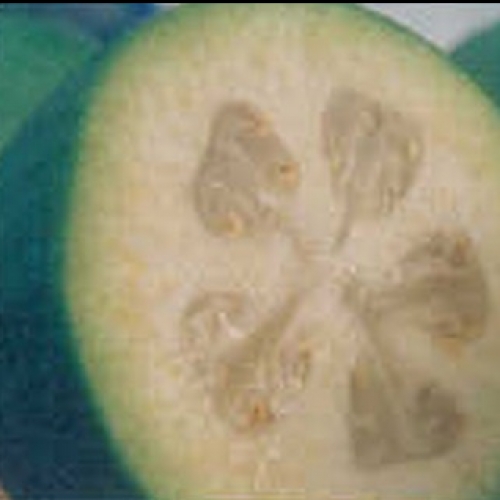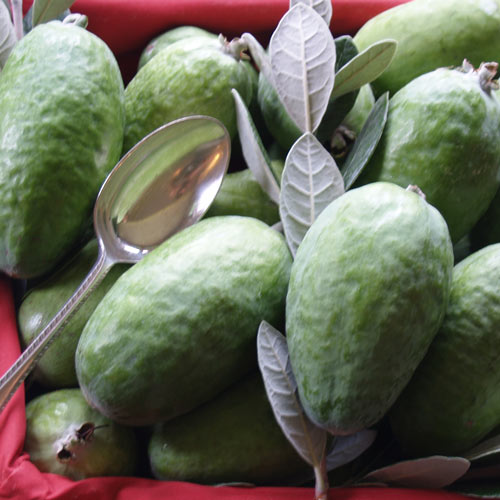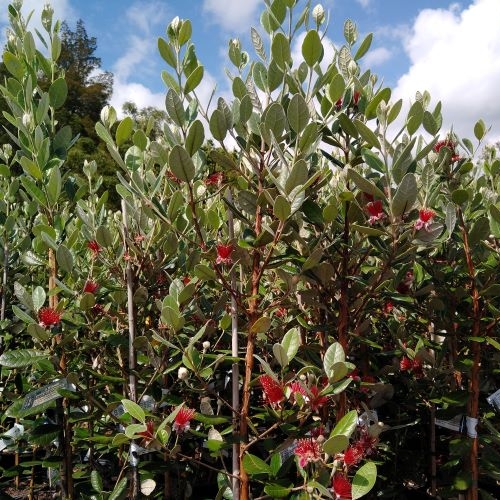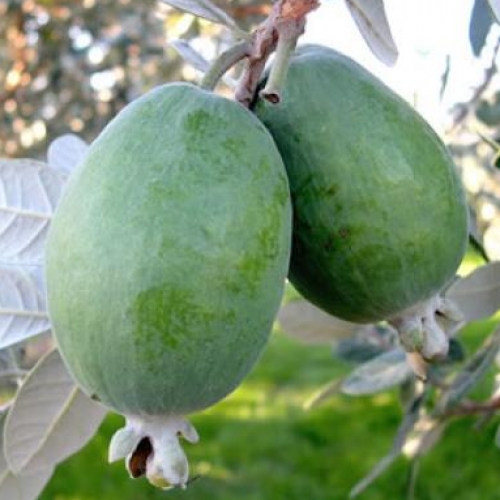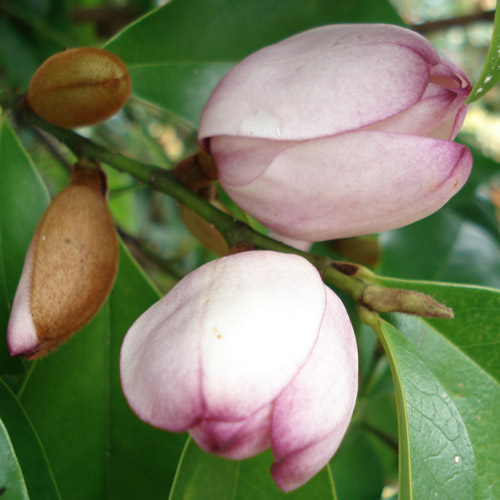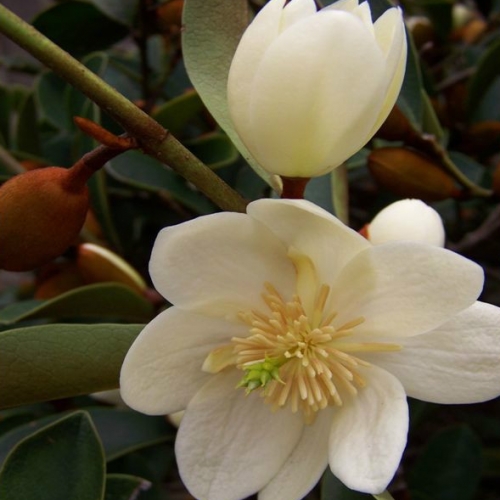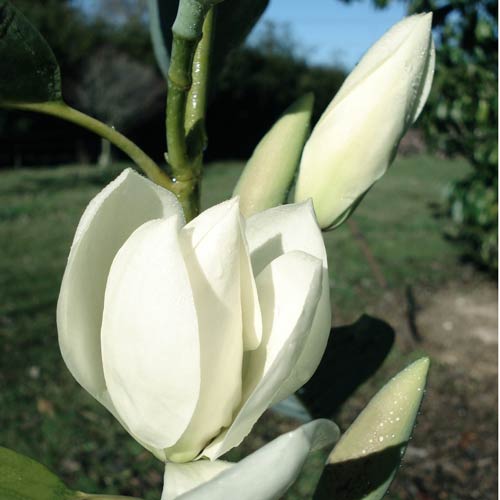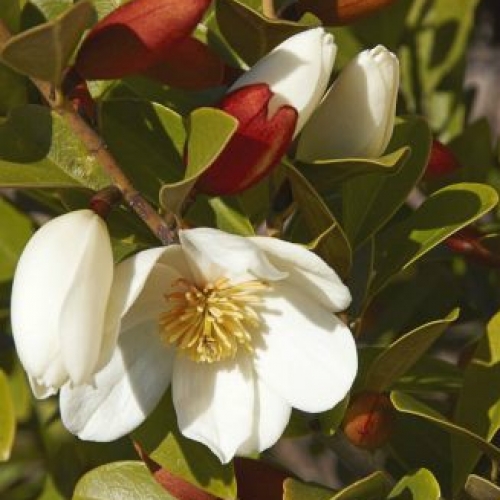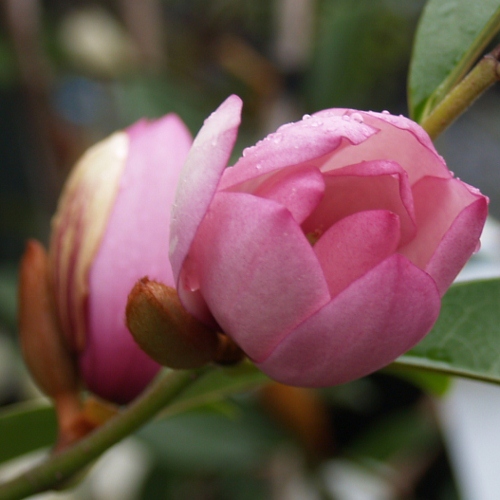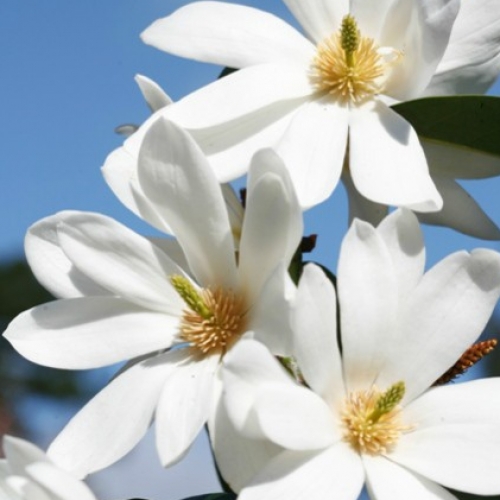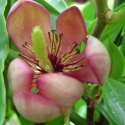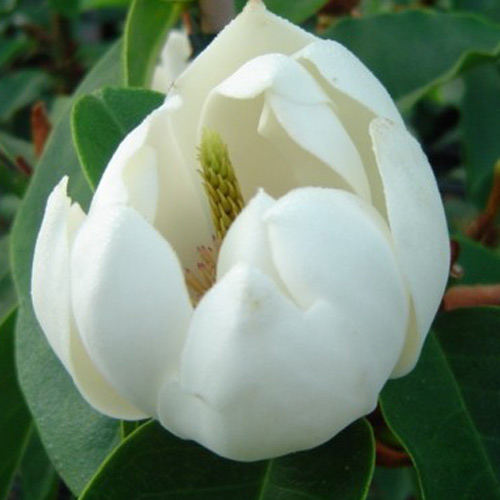Saturday 10th April, 2021
Hi
Pineapple Guavas, Feijoas... Whats in a name?
We have a line of
Feijoa bushes that were planted some years ago and so are becoming quite mature. Every day I bike past them and it never ceases to surprise me when, seemingly, suddenly, the Feijoas are there, having fallen to the ground. It's like they spend the whole season hidden away in the tree, then with a big rain they seem to complete that last growing bit really quickly, maybe they need that rain to plump up, and when you look in the trees they are chock full of lovely big fruit. Then I think how did I miss the amount of fruit developing there... maybe because they are green and small just like the leaves.
The best way to get a nice, ripe, Feijoa is to pick up the freshly fallen fruit everyday as it is too difficult to tell when they fell from the tree. This avoids the problem of over ripened fruit that has been sitting too long on the ground. Cathie uses the squeeze test, squeeze gently and if they squish they are too ripe, I think I like my way better!
Feijoas have another common name of Pineapple Guava, though I don't believe that this is commonly used here in NZ. They come from the southern parts of South America and seem to suit our temperate climate as they grow so easily and fruit really well. In fact I would rate Feijoas as being a very easy fruit to crop and produce such volume that you can turn them into any manner of fine food and preserves.
I am planning on doing a few Agee jars full of the fruit but through lockdown I made a pickle which was pretty yum, and it's all gone, so the plan is to make some more. Last year I decided that I prefer what I make to the stuff on the supermarket shelves and it would substitute nicely for the famous sauce that we all seem to smother over our bangers.
Rowan Bishop has a pretty awesome recipe book (and you absolutely need a copy) of relish chutney and pickles and the two that I made were Smoke & Lime Feijoa Chutney and Feijoa Pickle. This Feijoa Pickle is like a classic mustard pickle and was pretty easy to make, if I remember correctly, and just delicious. I actually bottled mine in small agee jars for a long shelf life but it's all gone, that is until one evening next week when I get will get busy and make some more.
Feijoa Pickle By Rowan Bishop
600g onions, 1.5kg Feijoas peeled and diced, 3 medium apples, 2 1/2 cups wine vinegar, 3 cups sugar, 60 g fresh or minced garlic, 60 g fresh or pre crushed garlic, 2 Tbsp dry mustard powder, 2 Tbsp mustard seeds, 3/4 cup sultanas or raisins, 1 tsp cardamon seeds, 1tsp whole cloves, 1 Tbsp turmeric, 3 Tbsp cornflour, 1/4 cup water
Peel and chop the onions into small dice, Peel and chop the Feijoas into small dice. Peel core and dice the apples.
Transfer the onions, Feijoas and apples to a large heavy based saucepan. Stir in the vinegar and sugar and bring to simmer point over a medium heat, stirring.
Add all of the remaining ingredients except cornflour and water. Turn down the heat and simmer, stirring regularly, for 40 to 45 minutes.
Combine the cornflour and water and add slowly stirring constantly, then simmer one minute. Pour the mix into hot, sterilised jars and seal with hot, sterilised screw on lids.
If you are missing having your own crop of fruit, then now is the perfect time to get some plants into the ground. I would suggest planting two or three different cultivars which will help pollinate each other and make for a slightly longer fruiting season.
Feijoa Apollo is a popular choice that has been around for a while with large sweet fruit.
Feijoa Anatoki, a desirable new variety that fruits early in the season around March-April. The fruit are exceptionally sweet, large and round. Yum Yum. As with all Feijoas will fruit best when 2 or more are planted.
Feijoa mammoth well it's called 'Mammoth' for a reason - big crops of big oblong shaped fruit that are full of flavour, ready to eat around May.
Feijoa Opal Star. This fabulous fruit has a dark skin with a rich and aromatic flavour. A late season variety ripening mid autumn. Self fertile but will do better with a partner.
Feijoa Pounamu. This smooth skinned variety of Feijoa also has smooth juicy flesh with a rich flavour. Pounamu has a high fruit yield and is ready early in the season around the end of March.
Feijoa Wiki Tu. An outstanding Feijoa with generous crops of large firm fruit that are ripe around about May. Forms a nice tidy evergreen tree. Can be grown alone but will perform better with a partner.
Michelias Magnolias .. its all a mixed up world with clever Kiwis
All Michelias are Magnolias but not all Magnolias are Michelias... I Guess that the name Michelia rather suggests a grouping within Magnolias. Interestingly... Michelias tend to have cluster flowers along their stems while Magnolias tend to carry blooms singly at the end of a stem.
Until recently there weren't very many cultivars of these handsome magnolia members and the mainstay were Figo, the port wine magnolia (that we all know smells like port wine or juicy fruit gum to some) or Doltsopa Silver Cloud.
Oswald Blumhardt was an early NZ plant pioneer and he was responsible for some of the early crosses of Michelia Figo and Silver Cloud which gave rise to Mixed Up Miss and Bubbles. Both quite handsome trees that have masses of fragrant flowers. Bubbles having a larger leaf, is more Doltsopa in form and I reckon Mixed Up Miss having the more Figo shape leaf.
Around 20 years ago we saw the intro of Michelia Yunnanensis and this species sets seed more readily and has paved the way for many more cultivars. I was also interested to learn that Michelia Yunnanensis is more correctly named Magnolia laeifolia but I have yet to see or hear anyone using this name so I guess we will just keep calling in Yunnanensis.
Mark Jury has continued breeding the Michelias and has brought to us the very popular Fairy Magnolia range being Blush, Cream and White which we should have stock of in due course. These have fragrant, medium size blooms of blush pink, cream and white and also an attractive leaf shape. They can be grown as small trees or even standardized and given an annual trim to keep to form.
I haven't mentioned Maudiae which was introduced by another rather talented NZ plants person... Peter Cave who brought this in from China. Maudaie has really attractive blue green leaves and when in flower is just a delight with masses of pure white fragrant starry shaped blooms.
We have has lots of enquiries about Walnuts and Persimmons so will talk about these next week when I'm up to date on the whole story re their on going shortage of supply. I hear it has to do with Covid of all things but more on this next week.
Don't you just love the Autumn with its lovely clear sunny days and the cooler evenings, although I am not so sure about the shorter days just yet. It's the perfect time for getting planting done right now with warm ground temps, some rain had and I m sure more to come. The growth in the garden has just romped away after that rain, so much so that I have had beautiful fresh pickings of good ole silver for dinner the past week. (Then I harvest the stuff and give it to the chooks every day too.) They just love it not to mention the oversize Kumi kumi that I break open for them.
Hopefully it will be another fine weekend to play and followed by another long weekend being ANZAC. Keep in mind that we don't open until 1pm on Sunday the 25th which is ANZAC day but otherwise we are open for business including the stat Mon 8.30 to 5pm.
However you are placed, have a fun weekend
Cheers Lloyd, Tony and the Wairere team>>>


